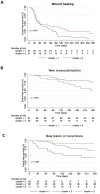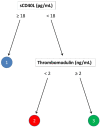Circulating Biomarkers of Endothelial Dysfunction and Inflammation in Predicting Clinical Outcomes in Diabetic Patients with Critical Limb Ischemia
- PMID: 36142551
- PMCID: PMC9506462
- DOI: 10.3390/ijms231810641
Circulating Biomarkers of Endothelial Dysfunction and Inflammation in Predicting Clinical Outcomes in Diabetic Patients with Critical Limb Ischemia
Abstract
Critical limb ischemia (CLI) is a severe manifestation of peripheral artery disease characterized by ischemic pain, which is frequently associated with diabetes and non-healing lesions to inferior limbs. The clinical management of diabetic patients with CLI typically includes percutaneous transluminal angioplasty (PTA) to restore limb circulation and surgical treatment of diabetic foot ulcers (DFU). However, even after successful treatment, CLI patients are prone to post-procedure complications, which may lead to unplanned revascularization or foot surgery. Unfortunately, the factors predicting adverse events in treated CLI patients are only partially known. This study aimed to identify potential biomarkers that predict the disease course in diabetic patients with CLI. For this purpose, we measured the circulating levels of a panel of 23 molecules related to inflammation, endothelial dysfunction, platelet activation, and thrombophilia in 92 patients with CLI and DFU requiring PTA and foot surgery. We investigated whether these putative biomarkers were associated with the following clinical endpoints: (1) healing of the treated DFUs; (2) need for new revascularization of the limb; (3) appearance of new lesions or relapses after successful healing. We found that sICAM-1 and endothelin-1 are inversely associated with DFU healing and that PAI-1 and endothelin-1 are associated with the need for new revascularization. Moreover, we found that the levels of thrombomodulin and sCD40L are associated with new lesions or recurrence, and we show that the levels of these biomarkers could be used in a decision tree to assign patients to clusters with different risks of developing new lesions or recurrences.
Keywords: critical limb ischemia; diabetes; diabetic foot ulcer; endothelial dysfunction; peripheral artery disease; wound healing.
Conflict of interest statement
The authors declare no conflict of interest.
Figures


Similar articles
-
Successful Revascularization has a Significant Impact on Limb Salvage Rate and Wound Healing for Patients with Diabetic Foot Ulcers: Single-Centre Retrospective Analysis with a Multidisciplinary Approach.Cardiovasc Intervent Radiol. 2020 Oct;43(10):1449-1459. doi: 10.1007/s00270-020-02604-4. Epub 2020 Aug 2. Cardiovasc Intervent Radiol. 2020. PMID: 32743744
-
Use of Integra Dermal Regeneration Template for Limb Salvage in Diabetic Patients With No-Option Critical Limb Ischemia.Int J Low Extrem Wounds. 2021 Jun;20(2):128-134. doi: 10.1177/1534734620905741. Epub 2020 Feb 14. Int J Low Extrem Wounds. 2021. PMID: 32056470
-
Long-term outcomes of diabetic patients with critical limb ischemia followed in a tertiary referral diabetic foot clinic.Diabetes Care. 2010 May;33(5):977-82. doi: 10.2337/dc09-0831. Epub 2010 Mar 3. Diabetes Care. 2010. PMID: 20200304 Free PMC article.
-
Cell therapy of critical limb ischemia in diabetic patients - State of art.Diabetes Res Clin Pract. 2017 Apr;126:263-271. doi: 10.1016/j.diabres.2017.02.028. Epub 2017 Feb 27. Diabetes Res Clin Pract. 2017. PMID: 28288436 Review.
-
Lower-extremity arterial revascularization: Is there any evidence for diabetic foot ulcer-healing?Diabetes Metab. 2016 Feb;42(1):4-15. doi: 10.1016/j.diabet.2015.05.004. Epub 2015 Jun 10. Diabetes Metab. 2016. PMID: 26072053 Review.
Cited by
-
Wound management, healing, and early prosthetic rehabilitation: Part 2 - A scoping review of physical biomarkers.Can Prosthet Orthot J. 2024 Dec 5;7(2):43716. doi: 10.33137/cpoj.v7i2.43716. eCollection 2024. Can Prosthet Orthot J. 2024. PMID: 39990247 Free PMC article. Review.
-
The Anti-Atherosclerotic Effects of Endothelin Receptor Antagonist, Bosentan, in Combination with Atorvastatin-An Experimental Study.Int J Mol Sci. 2024 Jun 16;25(12):6614. doi: 10.3390/ijms25126614. Int J Mol Sci. 2024. PMID: 38928320 Free PMC article.
-
The role of programmed cell death in diabetic foot ulcers.Int Wound J. 2023 Sep 22;21(2):e14399. doi: 10.1111/iwj.14399. Online ahead of print. Int Wound J. 2023. PMID: 37736955 Free PMC article. Review.
-
Relevance of the Extraction Stage on the Anti-Inflammatory Action of Fucoidans.Pharmaceutics. 2023 Mar 1;15(3):808. doi: 10.3390/pharmaceutics15030808. Pharmaceutics. 2023. PMID: 36986669 Free PMC article. Review.
-
Trans-ethnic Mendelian randomization analysis of membranous nephropathy and peripheral artery disease with mediating effects of thrombomodulin.Sci Rep. 2025 May 22;15(1):17800. doi: 10.1038/s41598-025-02626-3. Sci Rep. 2025. PMID: 40404751 Free PMC article.
References
MeSH terms
Substances
LinkOut - more resources
Full Text Sources
Medical
Research Materials
Miscellaneous

